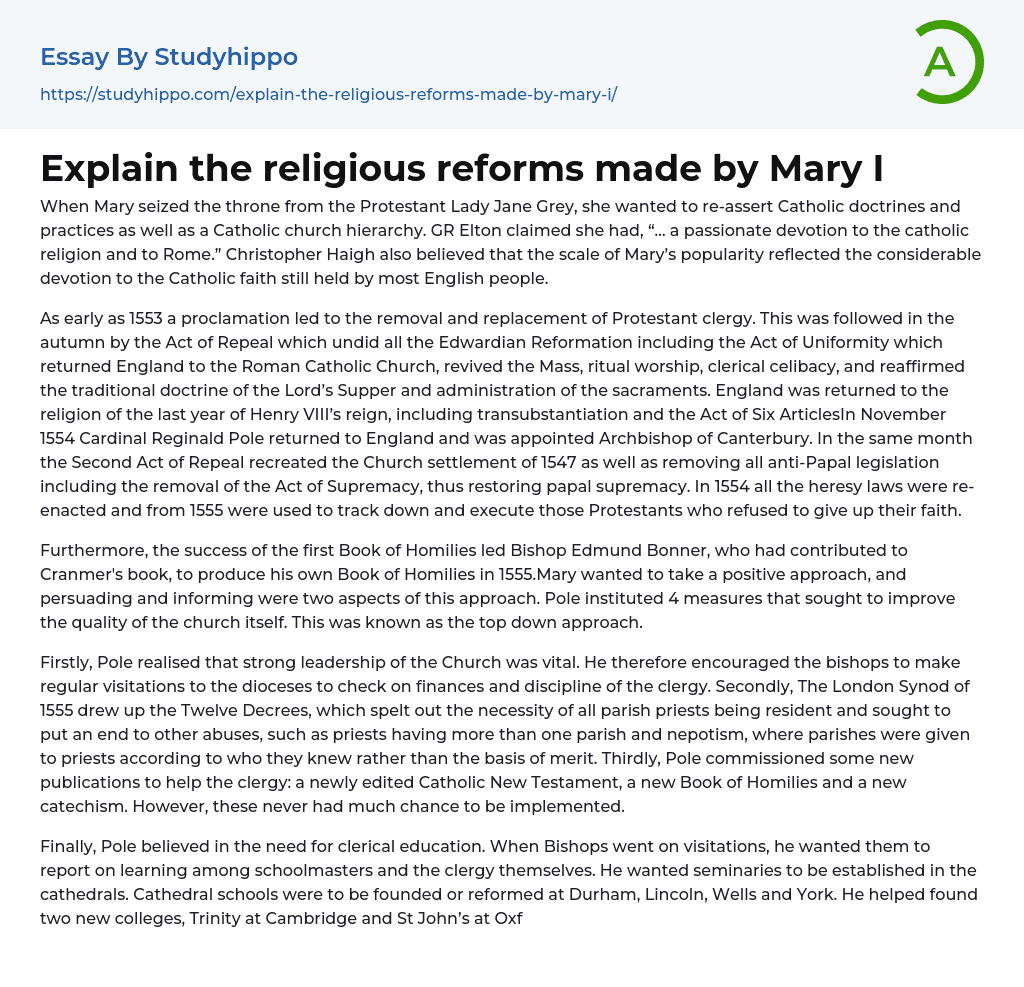

Explain the religious reforms made by Mary I Essay Example
When Mary seized the throne from the Protestant Lady Jane Grey, she wanted to re-assert Catholic doctrines and practices as well as a Catholic church hierarchy. GR Elton claimed she had, “… a passionate devotion to the catholic religion and to Rome.” Christopher Haigh also believed that the scale of Mary’s popularity reflected the considerable devotion to the Catholic faith still held by most English people.
As early as 1553 a proclamation led to the removal and replacement of Protestant clergy. This was followed in the autumn by the Act of Repeal which undid all the Edwardian Reformation including the Act of Uniformity which returned England to the Roman Catholic Church, revived the Mass, ritual worship, clerical celibacy, and reaffirmed the traditional doctrine of the Lord’s Supper and administration of the sacraments. England was return
...ed to the religion of the last year of Henry VIII’s reign, including transubstantiation and the Act of Six ArticlesIn November 1554 Cardinal Reginald Pole returned to England and was appointed Archbishop of Canterbury. In the same month the Second Act of Repeal recreated the Church settlement of 1547 as well as removing all anti-Papal legislation including the removal of the Act of Supremacy, thus restoring papal supremacy. In 1554 all the heresy laws were re-enacted and from 1555 were used to track down and execute those Protestants who refused to give up their faith.
Furthermore, the success of the first Book of Homilies led Bishop Edmund Bonner, who had contributed to Cranmer's book, to produce his own Book of Homilies in 1555.Mary wanted to take a positive approach, and persuading and informing were two aspects of this approach. Pole instituted
measures that sought to improve the quality of the church itself. This was known as the top down approach.
Firstly, Pole realised that strong leadership of the Church was vital. He therefore encouraged the bishops to make regular visitations to the dioceses to check on finances and discipline of the clergy. Secondly, The London Synod of 1555 drew up the Twelve Decrees, which spelt out the necessity of all parish priests being resident and sought to put an end to other abuses, such as priests having more than one parish and nepotism, where parishes were given to priests according to who they knew rather than the basis of merit. Thirdly, Pole commissioned some new publications to help the clergy: a newly edited Catholic New Testament, a new Book of Homilies and a new catechism. However, these never had much chance to be implemented.
Finally, Pole believed in the need for clerical education. When Bishops went on visitations, he wanted them to report on learning among schoolmasters and the clergy themselves. He wanted seminaries to be established in the cathedrals. Cathedral schools were to be founded or reformed at Durham, Lincoln, Wells and York. He helped found two new colleges, Trinity at Cambridge and St John’s at Oxford.
Furthermore, Mary had a policy of censorship. Early proclamations forbade the printing of seditious rumours in July 1553 or any material which concerned doctrine in August 1553. There was an index of proscribed writers and the possession of such material would result in the death penalty. Acts of Parliament made slander of Philip and Mary a treasonable offence and commissions were established to seek out such material. Additionally, Mary
persecuted some Protestants as reported by the Christian classic, Foxe’s Book of Martyrs.
This is where her reputation as ‘Bloody Mary’ came from. Trials and executions began some being important members of the clergy including Archbishop Thomas Cranmer, bishops Latimer, Ridley and Hooper but most were humble folk. Executions began in February 1555 and there were 300 in total lasting until November 1558 and concentrated in the sees of London and Norwich. Much of England saw no burnings at all.To conclude, three key features of the change back to Catholicism explain the success of the Marian Restoration: she acted without undue speed; she acted with the freely given consent of Parliament and the regime was not unduly vengeful in the first few years towards its Protestant enemies.
Christopher Haigh believed, “The Marian reconstruction of Catholicism was a success,” citing evidence from the parishes of proof of continuing support for traditional services and celebrations. That and the fact that the number of priests entering holy orders being the highest it had been in 30 years clearly showed that Mary had succeeded in restoring Roman Catholicism. Haigh said her only mistake was that she died.
- Baptism essays
- Holy Spirit essays
- Jesus Christ essays
- Adam And Eve essays
- Crucifixion Of Jesus essays
- Crusades essays
- Eucharist essays
- God The Father essays
- Pope essays
- Protestantism essays
- Christian essays
- Church essays
- Elizabeth essays
- Sacrament essays
- Catholic Church essays
- Lord essays
- Priest essays
- Protestant Reformation essays
- Afterlife essays
- Atheism essays
- Bible essays
- Buddhism essays
- Christian Worldview essays
- Christianity essays
- Confession essays
- Cosmological Argument essays
- Deism essays
- Devil essays
- Existence of God essays
- Faith essays
- Freedom Of Religion essays
- God essays
- Hinduism essays
- Immortality essays
- Islam essays
- Jainism essays
- Jews essays
- Judaism essays
- Miracle essays
- Monk essays
- Monotheism essays
- New Testament essays
- Old Testament essays
- Pilgrimage essays
- Puritans essays
- Revelation essays
- Ritual essays
- Salvation essays
- Sin essays
- Sinners essays



